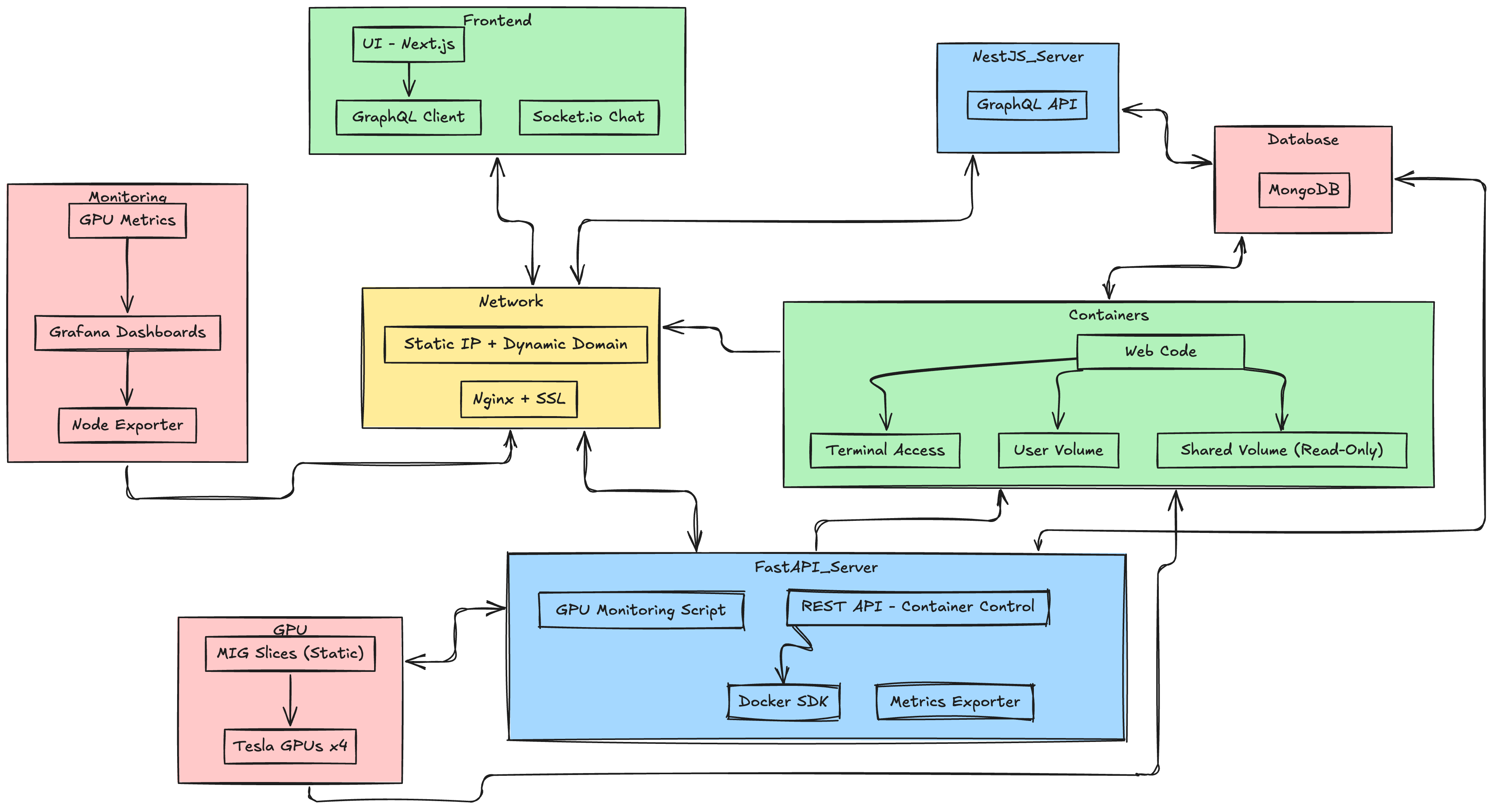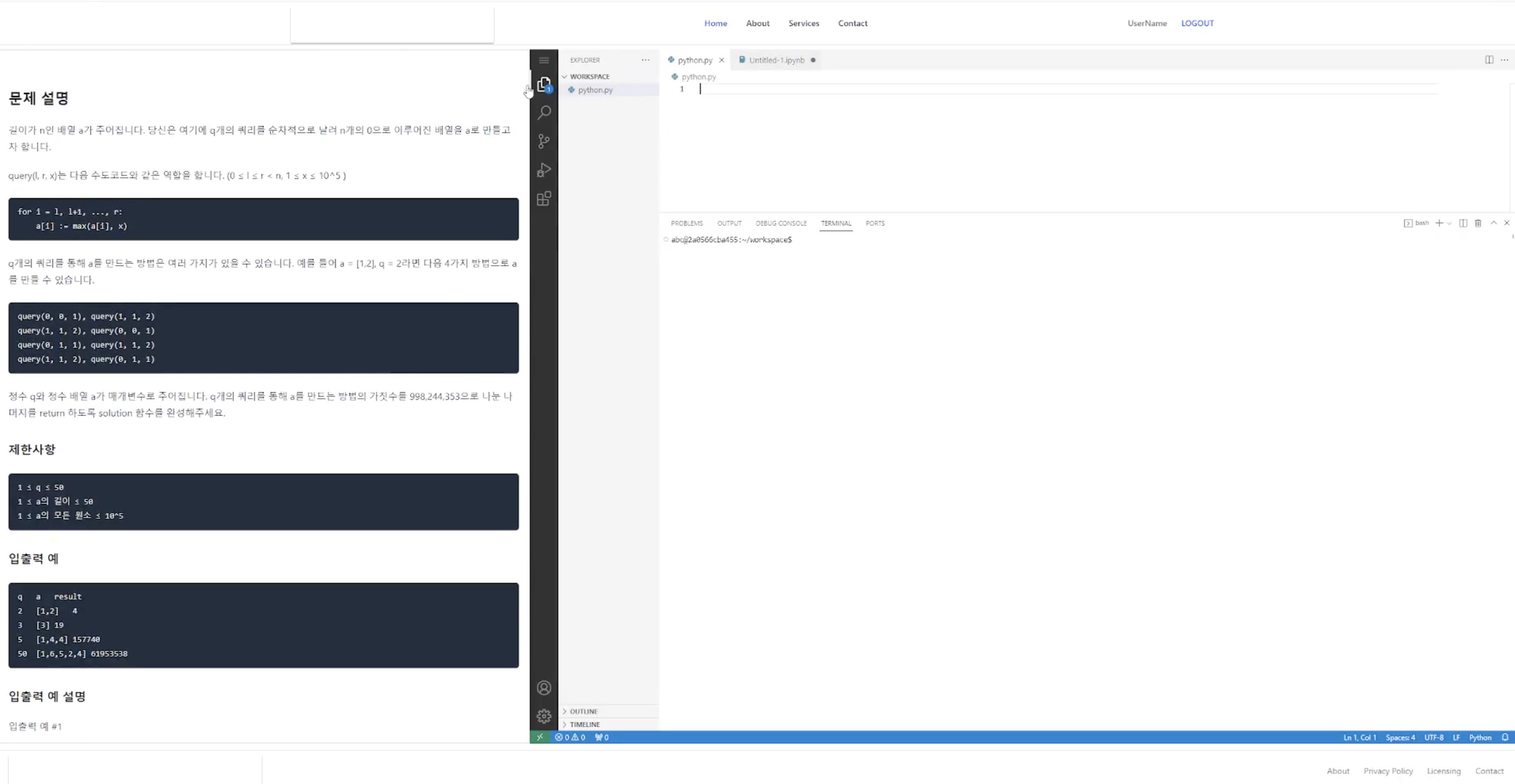AI Education Platform
Overview
A self-hosted, scalable platform for teaching and experimenting with artificial intelligence in controlled educational environments. The platform enables students and researchers to access isolated Jupyter-based development environments on GPU-backed infrastructure. Inspired by Google Colab, the system is tailored for on-premise GPU use, with full container control, secure web access, integrated chat, assignment delivery, and detailed system monitoring.
Designed and implemented by Alexander Kim in 2023–2024 for a national educational research project in Korea. The system supported over 40 concurrent users during live AI classes and successfully replaced the need for commercial cloud services.
Objectives
- Democratize access to GPU resources for students in a classroom/lab setting
- Provide isolated, reproducible, and secure environments for each user
- Enable real-time interaction, file sharing, and code collaboration
- Offer per-user monitoring of GPU and system usage
- Reduce cost compared to cloud-based alternatives like Google Colab or AWS
Core Features
🔹 Frontend
- Next.js-based Web UI: Clean, responsive interface with student-friendly layout
- GraphQL Client: Interactive communication with backend for notebooks, sessions, and metadata
- Socket.io Chat: Real-time communication for support, announcements, and Q&A
- Notebook Management: Create, restart, and delete containers from the frontend
- Authentication: Role-based access (admin/teacher/student)
🔹 Backend (Dual-Service Architecture)
- NestJS API Server:
- GraphQL API (user, session, notebook management)
- MongoDB integration for persistent user/session storage
- FastAPI Control Server:
- REST endpoints for Docker container lifecycle management
- GPU allocation logic (static MIG mapping per user)
- SSE/Prometheus-compatible exporters for monitoring
- Custom GPU scripts using
nvidia-smi,pynvml
🔹 Dockerized Learning Environments
- Jupyter Notebook + Terminal
- User-specific volumes (isolated home folders)
- Read-only shared volumes for distributing teaching materials
- Preinstalled packages (PyTorch, TensorFlow, Scikit-learn, etc.)
🔹 GPU Infrastructure
- Tesla V100 x4 with MIG slicing (static allocation)
- Each container mapped to a MIG slice (guaranteed isolation)
- Scripts to manage container ↔ MIG mapping
🔹 Monitoring
- Prometheus + Grafana Dashboards
- Custom GPU exporters (per MIG slice)
- Node Exporter for system-level metrics
- Dashboards for teachers: active users, GPU load, notebook status
🔹 Networking & Deployment
- Nginx reverse proxy with SSL termination
- Static IP and dynamic DNS (e.g., via DuckDNS)
- Self-hosted on bare metal (Ubuntu server)
- Docker Compose orchestration for all services
Architecture Diagram

Frontend: Next.js + GraphQL Client + Socket.IO
Backend 1 (NestJS): GraphQL API + MongoDB
Backend 2 (FastAPI): REST API + Docker SDK + GPU Metrics
Containers: Jupyter Notebook + Terminal + User Volumes
Monitoring: Prometheus + Node Exporter + Custom GPU Exporter + Grafana
Infrastructure: Tesla GPUs x4 + MIG slices + Nginx + Static IP + Docker Compose
User Interface

Clean, responsive interface designed for educational use with student-friendly layout and intuitive navigation.
Use Cases
- University-level AI coursework (20–40 students)
- Workshops or bootcamps in deep learning
- Research labs requiring multi-user Jupyter access
- Safe alternative to commercial notebooks for schools with privacy/legal constraints
Key Technologies
| Layer | Technologies |
|---|---|
| Frontend | Next.js, TypeScript, Apollo Client, socket.io |
| Backend | NestJS (GraphQL), FastAPI (REST), MongoDB, Docker SDK |
| Monitoring | Prometheus, Grafana, Node Exporter, Custom GPU Exporters |
| GPU Tools | NVIDIA MIG, nvidia-smi, pynvml |
| Infra | Nginx, Docker, Docker Compose, SSL, Static IP + DDNS |
| DevOps | Docker Volumes, shell scripts, recovery automation |
Engineering Highlights
- Designed a dual-backend architecture to separate API logic from low-level GPU/container control
- Enabled multi-user isolation using MIG and Docker volumes
- Implemented robust fault-recovery and container health monitoring
- Built a chat layer with optional teacher moderation
- Used Prometheus exporters to trace GPU load per student in real time
- Integrated auto-mounting of teaching materials into student containers
Challenges Solved
- MIG management: Static allocation and mapping without breaking container health
- GPU resource fairness: One MIG slice per student, enforced via control server
- Monitoring granularity: Metrics by GPU slice, not global GPU usage
- Security: Nginx reverse proxy, role-based access, isolated volumes
- Uptime: Restart scripts and health checks for critical services
Future Plans
- Auto-grading via Jupyter nbconvert + test runners
- Admin dashboard for real-time control of sessions
- User activity logs and performance heatmaps
- OAuth login for LMS integration (Google Classroom, Moodle)
- Container auto-scaling based on load